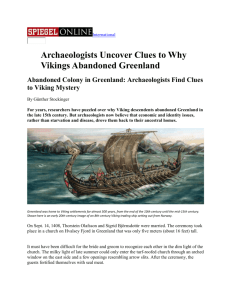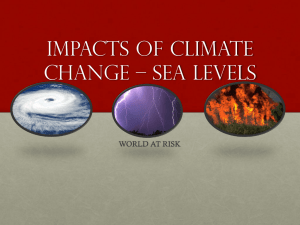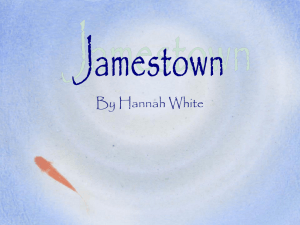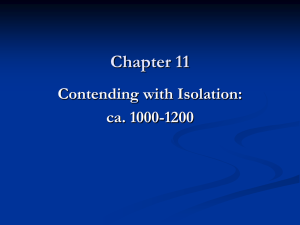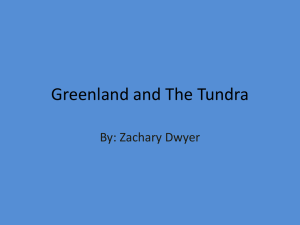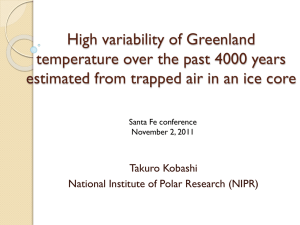Ch. 1 Additional Activities
advertisement
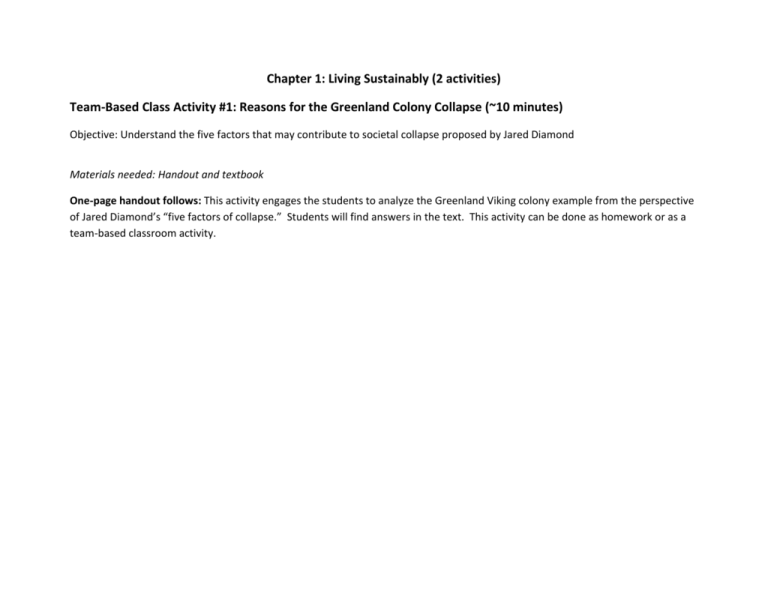
Chapter 1: Living Sustainably (2 activities) Team-Based Class Activity #1: Reasons for the Greenland Colony Collapse (~10 minutes) Objective: Understand the five factors that may contribute to societal collapse proposed by Jared Diamond Materials needed: Handout and textbook One-page handout follows: This activity engages the students to analyze the Greenland Viking colony example from the perspective of Jared Diamond’s “five factors of collapse.” Students will find answers in the text. This activity can be done as homework or as a team-based classroom activity. Analysis: Diamond’s Five Factors Identify how each of these five factors played a role in the demise of the Greenland Viking Colony. Factor Natural climate change Self-inflicted environmental damage Failure to respond to the natural environment Hostile neighbors Loss of friendly neighbors How it applies to the Vikings Answers Analysis: Diamond’s Five Factors Identify how each of these five factors played a role in the demise of the Greenland Viking Colony. Factor Natural climate change How it applies to the Vikings The Little Ice Age brought colder weather and reduced the ability of ships to sail from Europe to Greenland. Self-inflicted environmental damage They overgrazed grasslands and overharvested sod and trees. This degraded the area and reduced its ability to produce these resources. Hostile neighbors They did not notice, or ignored, the degradation of their ecosystem and continued to try to live as they would have in Europe (building wood structures, raising livestock). They also avoided the use of locally abundant food resources such as fish. They had clashes with the Inuit. This prevented them from befriending the Inuit and learning from them how to live in this area. Loss of friendly neighbors The sea ice reduced, and eventually stopped, the visits of European ships, so they lost their source of imported goods on which they depended. Failure to respond to the natural environment Team-Based Class Activity #2: Greenland Colony vs. Modern Society (20–30 minutes; will be quicker if done as one “big group” during lecture, asking for volunteers to offer answers) Objectives: a) Understand the four characteristics of a sustainable ecosystem. b) Evaluate the actions of the Greenland colony by identifying how their choices violated some of these characteristics and propose alternative actions that would have allowed the colony to mimic a sustainable ecosystem. c) Evaluate the actions of modern society by identifying how our choices violate all of these characteristics and propose alternative actions that would allow us to mimic a sustainable ecosystem. Materials needed: Handout (textbook may come in handy if you choose to let students use it—this generally takes more time, however, since unprepared students will take the time to look up and read about these topics.) Two-page handout follows: This activity asks students to apply the concepts of the characteristics of a sustainable ecosystem, as presented in Chapter 1, to the examples of the Greenland Viking colony and to modern society. This is an application activity that requires the students to make these connections themselves (examples of how modern society could avoid violating these actions are in IG 1.5, but examples of how it violates them are not). This works well as a team-based activity and can be used as a graded activity or an ungraded activity. It can also be done with the class at large during lecture by asking for volunteer answers or calling on students at random. (If students are called on for an answer, allow them to “phone a friend”—i.e., ask another student in the class for help.) Application Activity: Sustainability and Greenland (Refer to IG 1.5 to answer the following.) TEAMS: You are GREENLAND COLONY. What did you do wrong, and what sustainability characteristics did these actions violate? What could you have done to avoid that? GREENLAND COLONY Sustainable ecosystems Was this characteristic violated? If so, how? Alternate action to avoid this? (Write N/A if not violated) What about MODERN SOCIETY? Identify one way we are violating each sustainability characteristic. What can we do to address that? MODERN SOCIETY Sustainable ecosystems How is this characteristic violated? Alternate action to avoid this? (Write N/A if not violated) Answers Application Activity: Sustainability and Greenland (Refer to IG 1.5 to answer the following.) TEAMS: You are GREENLAND COLONY. What did you do wrong and what sustainability characteristics did these actions violate? What could you have done to avoid that? GREENLAND COLONY Sustainable ecosystems Was this characteristic violated? If so, how? Not violated – relied on plant-based energy sources Trees and grasses were harvested faster than they regrew; the use of livestock on pastures degraded the pastureland, reducing its ability to recover. Alternate action to avoid this? (Write N/A if not violated) N/A They should not raise cattle on these pastures; alternate building and insulating materials should have been used and perhaps smaller structures built. Alternate food sources should have been used such as fish. Livestock populations were too large for the ecosystem (perhaps none could be tolerated). The Viking population size may have been bigger than the area could support. Reduce or eliminate livestock herds; reduce family size. Rather than using local resources, they continued to depend on imports and when ships stopped coming, they had no alternative materials to use. Depending only on local resources for food and building materials (like the Inuit) would have allowed them to survive, even when the European ships stopped coming. What about MODERN SOCIETY? Identify one way we are violating each sustainability characteristic. What can we do to address that? MODERN SOCIETY Sustainable ecosystems How is this characteristic violated? Alternate action to avoid this? (Write N/A if not violated) Yes. We depend heavily on fossil fuels rather than renewable energy sources. And in some cases, when we do use renewable energy sources, we use them faster than they are replaced (i.e., wood). Turn to renewable energy sources such as solar, wind, geothermal, and biomass (harvested at a sustainable rate). We use matter resources faster than they are replaced and often use matter once and then discard it or leave it in a form that is not readily used again. Conservation to reduce wasteful use of matter resources; use matter in a way that allows it to be re-used and recycled; reduce the release of toxins that degrade the environment that provides these resources. Our own population is huge—7 billion+. There are indications that the rate of resource consumption by our population far exceeds the ability of the Earth to renew these resources. Steps to reduce further population growth are needed. (This is preferable to the reduction of human populations through war or disease.) Our actions endanger species, shrinking biodiversity. We also tend to rely on a small number of food species, energy sources or other matter resources, relative to what is available in nature. Protecting biodiversity allows nature to produce the resources and ecosystem services we need. We can also emulate the diversity of nature in other choices. Examples: No single energy source can replace fossil fuels, but a variety can; growing or harvesting food that naturally grows in an area is better than forcing corn or rice to grow everywhere.

